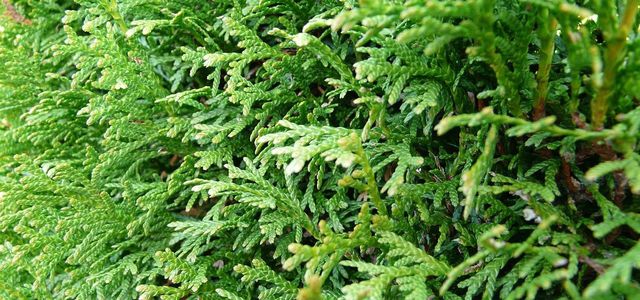
Planting thuja: Multifaceted plant
Thuja is a popular plant for gardens and parks. The cypress species grows densely and is easy to cut into shape. Its opaque foliage makes it especially popular for hedges. The species, also known as the tree of life, originates from North America and Asia, where wild-growing species such as the giant tree of life are among the largest conifers of all, reaching up to 200 meters, as the forestry information service waldwissen.net explains. In our latitudes, it is predominantly the smaller occidental tree of life that is cultivated.
Contents
Planting thuja – here’s how you do it
Planting Thuja is not difficult. If you want to plant the evergreen plant in your garden, you should consider a few things when it comes to location and care:
Location and soil
- Thuja grows best in a full sun to partial shade location.
- The right soil is especially important for the coniferous tree: trees of life require continuously moist soil, which should never remain dry for long, even in summer.
- A calcareous, slightly sandy loam soil is ideal.
- The thuja is quite adaptable when it comes to the pH value of the soil. With sufficient nutrients – such as humus, compost or homemade organic fertilizer, the ornamental plant can grow even in acidic soils.
Planting and caring for Thuja
The best time to plant thuja is in the fall or spring.
When planting, pay attention to the variety of Thuja. Species that grow wild tend to grow very wide and quickly take each other’s space. For hedges are therefore suitable somewhat narrower varieties such as “Thuja Holmstrup” or “Thuja Smaragd”.
If your garden soil is very heavy and firm, mix the planting soil for the thuja with some sand.
Place your young thuja trees about 50 centimeters apart in the planting holes. This way the trees have enough space to spread out.
Of course, you can also plant thuja individually. Especially the small and roundish growing ornamental varieties like “Gold-Lebensbaum Rheingold” look pretty in a tub. Small varieties are also suitable for a rock garden.
Water your evergreen plant regularly, even in winter.
Since the plant prefers nutrient-rich soil, regular fertilizing is advisable. Especially in spring you can strengthen your Thuja with fertilizer for the new growing season. Suitable fertilizers are humus, compost or homemade organic fertilizer.
Pruning Thuja
For a dense growth without bare spots you should prune your Thuja regularly.
The best time to prune is before new shoots appear. It can be done in late autumn or early spring.
Be careful when pruning and only cut back shoots that stick out for a long time.
Never cut across the needle boundary to the bare wood. The plant would then need a very long time to develop green needles again at the intersections.
Important: Since Thuja is poisonous, be sure to use gloves!
Planting thuja: Advantages and disadvantages

Although the exotic thuja is a pretty evergreen plant, it is only partially suitable for ecological garden design. Before you plant a thuja hedge, you should weigh the pros and cons of the tree of life:
Advantages:
- Beautiful hedge plant with dense growth. Good privacy screen.
- Relatively easy to maintain
- Winter hardy
Disadvantages:
- Thuja is poisonous in all parts, as you can read in more detail at the Poison Information Service-North. However, the poisonous substance thujone is particularly concentrated in twig tips and cones.
- Because of the toxicity, the tree is difficult for gardening. Both wildlife and pets can be poisoned by accidentally eating the plant parts.
- The tree of life can also be dangerous to children playing. The sap from the plant can cause severe skin irritation and itching.
- Thuja has no particular ecological use. Now and then it can serve as a nesting place for birds. However, due to its dense growth and upward growing needles, other trees are more suitable for this purpose.
- If the tree is not cared for properly, if it is not watered enough or if it is pruned back too much, the cypress plant will quickly become bare. In the long run, this looks unsightly and weakens the plant.
Native alternatives to thuja and other exotics
If you want to plant a beautiful hedge, native shrubs are better suited from an ecological perspective. With a combination of different native wild shrubs, you not only maintain biodiversity, but also provide wildlife with a much wider range of food and nesting opportunities than with exotic plants, depending on their preferences.
Well-suited plants for a natural hedge include:
- Bird cherry (especially popular with wild birds)
- Wild rose
- Wild blackberry
- Hazelnut
- Dogwood
- Black elderberry
- Blackthorn
- Hawthorn
- Willow
- Cherry laurel
There is a wide variety of plants to choose from for a natural hedge with native shrubs and trees. As a tip, base your plant selection on the native vegetation of wild plants and cultivate portions of them in your wildlife hedge. Since native shrubs are adapted to location and weather, you are on the safe side with them.

